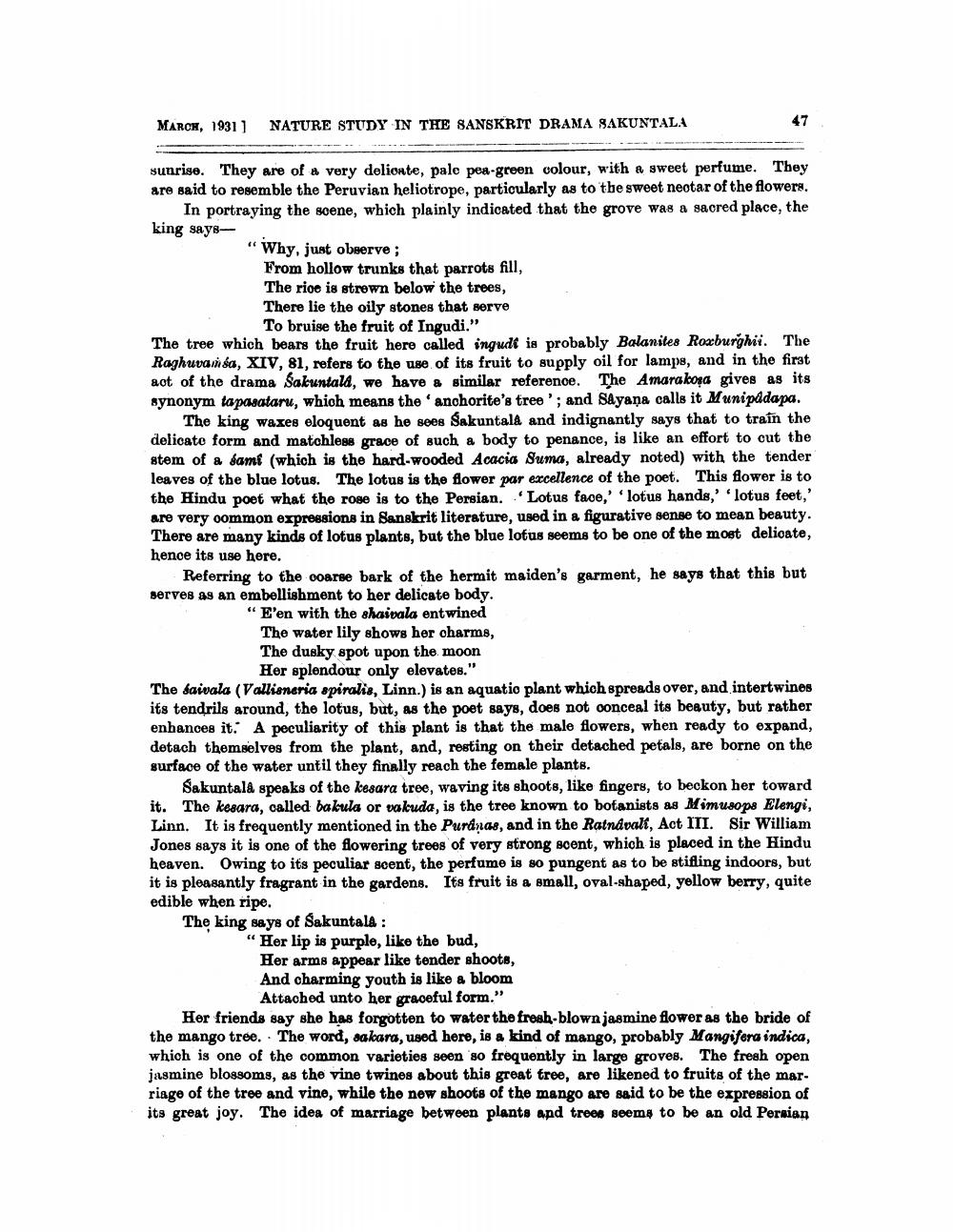________________
MARCH, 1931) NATURE STUDY IN THE SANSKRIT DRAMA SAKUNTALA
47
sunrise. They are of a very delionte, pale pea-green colour, with a sweet perfume. They are said to resemble the Peruvian heliotrope, particularly as to the sweet neotar of the flowers.
In portraying the soene, which plainly indicated that the grove was a sacred place, the king says
"Why, just obeerve;
From hollow trunks that parrots fill, The rioe is strewn below the trees, There lie the oily stones that serve
To bruise the fruit of Ingudi." The tree which bears the fruit here called ingude is probably Balanites Roxburghii. The Raghuvarica, XIV, 81, refers to the use of its fruit to supply oil for lamps, and in the first aot of the drama Sakuntald, we have a similar referenoe. The Amarakoşa gives as its synonym tapanataru, which means the anchorite's tree'; and Sayana calls it Munipidapa.
The king waxes eloquent as he sees Sakuntald and indignantly says that to train the delicato form and matchless grace of such a body to penance, is like an effort to cut the stem of a samf (which is the hard-wooded Acacia Suma, already noted) with the tender leaves of the blue lotus. The lotus is the flower par excellence of the poet. This flower is to the Hindu poet what the rose is to the Persian. Lotus faoe,' 'lotus hands, lotus feet,' are very oommon expressions in Sanskrit literature, used in a figurative sense to mean beauty. There are many kinds of lotus plants, but the blue lotus seems to be one of the most delicate, hence its use here.
Referring to the coarse bark of the hermit maiden's garment, he says that this but serves as an embellishment to her delicate body.
"E'en with the shaivala entwined
The water lily shows her charms, The dusky spot upon the moon
Her splendour only elevates." The Saivala (Vallisneria spiralis, Linn.) is an aquatio plant which spreads over, and intertwines its tendrils around, the lotus, but, as the poet says, does not oonceal its beauty, but rather enhances it. A peculiarity of this plant is that the male flowers, when ready to expand, detach themselves from the plant, and, resting on their detached petals, are borne on the surface of the water until they finally reach the female plants.
Sakuntala speaks of the kesara tree, waving its shoots, like fingers, to beckon her toward it. The kesara, called bakula or vakuda, is the tree known to botanists as Mimusops Elengi, Linn. It is frequently mentioned in the Puranas, and in the Ratndvalt, Act III. Sir William Jones says it is one of the flowering trees of very strong soent, which is placed in the Hindu heaven. Owing to its peculiar scent, the perfume is so pungent as to be stifling indoors, but it is pleasantly fragrant in the gardens. Its fruit is a small, oval-shaped, yellow berry, quite edible when ripe. The king says of Sakuntala:
'Her lip is purple, like the bud, Her arms appear like tender shoots, And charming youth is like a bloom
Attached unto her graceful form." Her friends say she has forgotten to water the fresh-blown jasmine flower as the bride of the mango tree. The word, sakara, used here, is a kind of mango, probably Mangifera indica, which is one of the common varieties seen so frequently in large groves. The fresh open jasmine blossoms, as the vine twines about this great tree, are likened to fruits of the marriage of the tree and vine, while the new shoots of the mango are said to be the expression of its great joy. The idea of marriage between plants and trees seems to be an old Pernian




